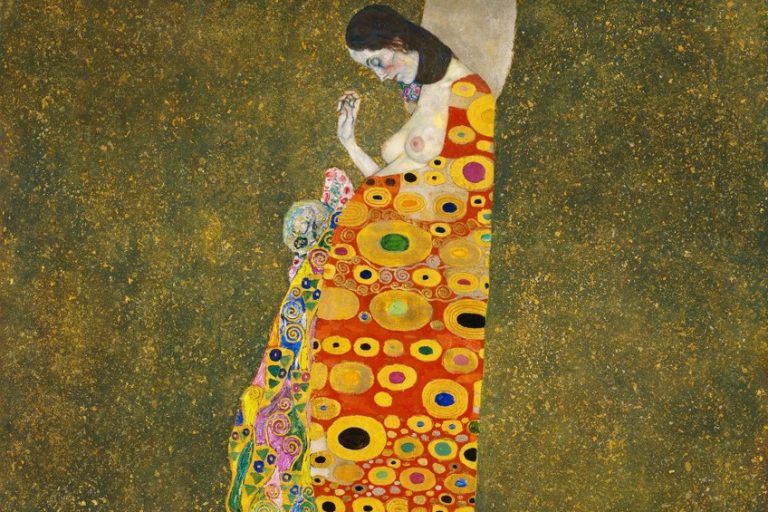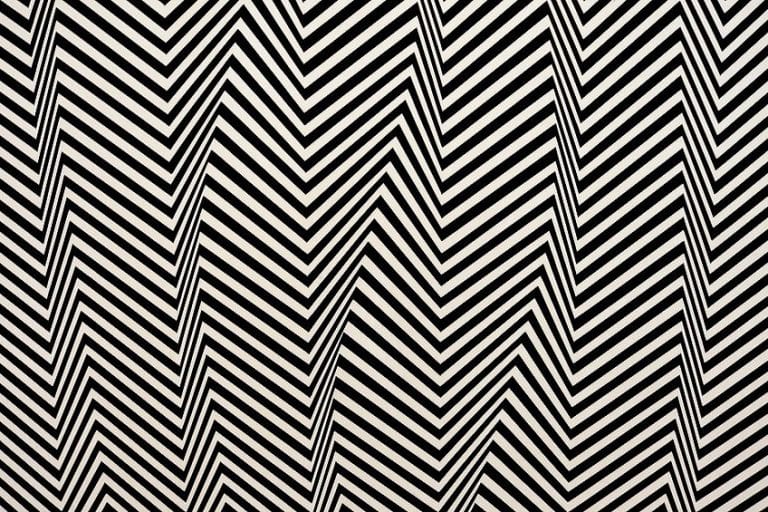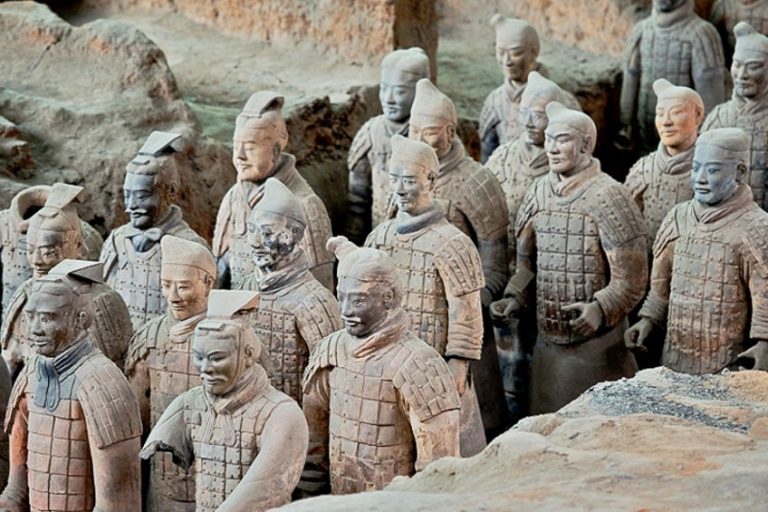Chicano Art – Discover the Mexican American Art of Chicano Painters
The Chicano art movement refers to the ground-breaking Mexican-American art movement in which artists developed an artistic identity, heavily influenced by the Chicano movement of the 1960s. Chicano artists aimed to form their own collective identity in the art world, an identity that promoted pride, affirmation, and a rejection of racial stereotypes. The most well-known and famous Chicano artists include Carlos Almaraz, Chaz Bojórquez, Richard Duardo, Yreina Cervántez, and Magú. Chicano artists developed their works to exist as a form of a community-based representation of life in the barrio, but it also acted as a form of activism for social issues faced by Latin-American people in the United States.
Table of Contents
- 1 The Chicano Art Movement
- 2 History of the Chicano Art Movement and Its Forms
- 3 Notable Artists and Artworks of the Chicano Art Movement
- 4 Frequently Asked Questions
The Chicano Art Movement
The Chicano art movement began in the late 1960s and early 1970s, alongside the growth of the Chicano movement, or El Movimiento, and was created and defined by Mexican people, or people of Mexican descent living in the United States. The term “Chicano” is used interchangeably with “Mexican-American”, emerging from the youth who rejected assimilation to the Euro-Centric American culture. The term was widely used in the 1960s and 1970s and became associated with indigenous pride, culture affirmation, ethnic solidarity, and political empowerment.
The Chicano art movement involved Chicano artists forming and establishing a specific and unique artistic identity, that diverted from the mainstream United States art forms.
As the movement was meant to represent a rejection of the White-American culture and its forms of art, the Chicano movement aimed to form and develop a collective identity that distinguished itself as Mexican-American. Chicano muralists and Chicano painters drew their inspiration from Mexican murals and Pre-Columbian Art. Pre-Columbian art refers to works made by the Aztec, Inca, Mayan, and Native Mexican people.
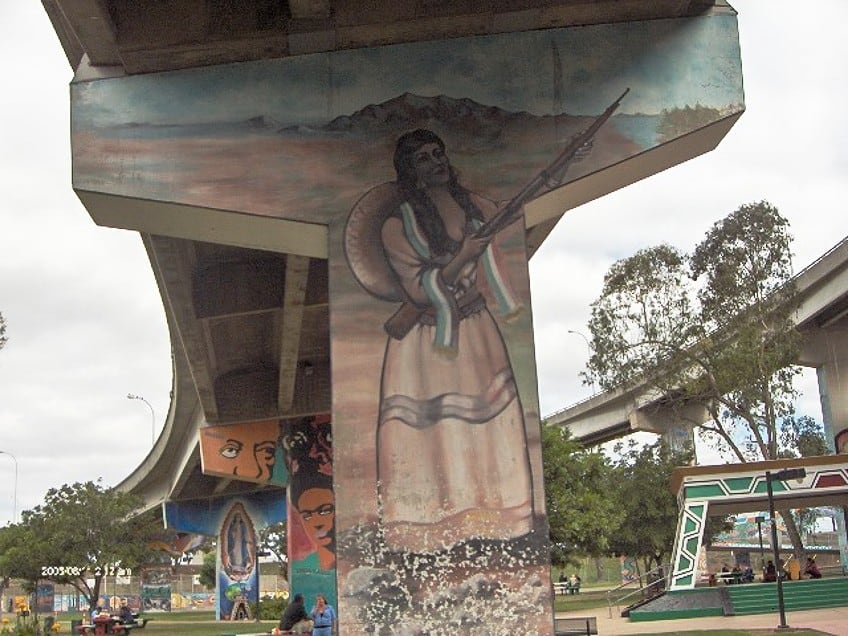
These communities, all native to Latin America or South America, were heavily disrupted by the colonization by the Spanish conquistadors. The Chicano movement, and by extension, the Chicano art movement aimed to reject the dominant White American culture, which their ancestors were unable to do when the Spanish invaded. Chicano artists developed their work as an expression of their experiences and culture.
Often, Chicano art drawings feature the subject of “rasquachismo”, which refers to the Spanish word, “rasquache”, which means “poor”.
Rasquachismo refers to the cultural attitude to always be hard-working and resourceful, getting by with the few resources they tend to have in a society dominated by wealthy White Americans. In other words, the Chicano art movement was meant to be a form of protest, with the artwork often being very direct and vibrant. Chicano mural paintings not only promoted community in their subject matter but often involved community members in their creation; discussing and formulating what they wanted to depict based on their cultural history and struggles.

These murals were often painted by self-taught artists, which again shows the movement’s value for resourcefulness. These murals were usually painted on public walls, where entire communities would be able to see by walking or driving by. The public nature of this art form emphasized histories that were often overshadowed by the White-American narrative, which tended to present historical events in a pro-European light. This public nature allowed for audiences to be politicized and mobilized without expecting them to go into an art gallery or museum.
Besides murals, Chicano artists also used silkscreen creations, which allowed for the production of posters and printed images, that could be distributed in large numbers, spreading the political and social aspect of the Chicano movement.
The subject matter of Chicano art commonly features imagery relating to issues of immigration and displacement, issues that the Latin communities of the United States often dealt with. Mexicans often struggle with immigration to the United States and native Mexicans and South Americans were being displaced by Spanish and Portuguese colonization.
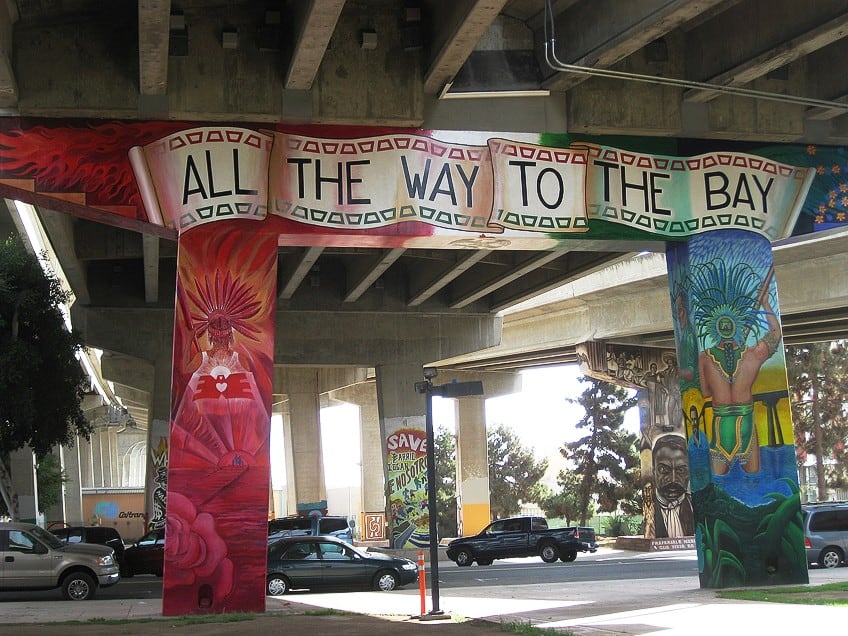
The works of Chicano art also specifically depicted the human rights violations faced by the Mexican Americans in the Southwest of the United States, including racial profiling, as well as xenophobic immigration issues faced by undocumented immigrants about the militarization of the border. By 1990, Chicano art began to gain significant exposure, with a traveling exhibition called Chicano Art: Resistance and Affirmation. The exhibition opened at the University of California, Los Angeles, at the Wight Gallery.
The committee stated that “Chicano art is the modern, ongoing expression of the long-term cultural, economic, and political struggle of the Mexicano people within the United States. it is an affirmation of the complex identity and vitality of the Chicano people.” The movement continues to this day, with Chicano artists evolving alongside the subject matter, incorporating newer social issues as they come up in a society that continues to be dominated by the White-American culture, and oppresses Mexicans and other Latin-Americans.
Contemporary Chicano art features a broad range of subject matter, as well as many different mediums.
History of the Chicano Art Movement and Its Forms
The Chicano movement, at its core, was a socio-political movement in which Mexican-Americans came together as a unified entity to create a change for their people. The movement dealt with several issues the Mexican and Latin-American communities faced in the US, such as civil rights issues, the lack of social services that were available for Mexican-Americans, issues of educational rights and quality, as well as police brutality, and the Vietnam War.
The movement was open to all Mexican-Americans, regardless of age or gender, which allowed for discussions on generational issues, as well as the rights of women.
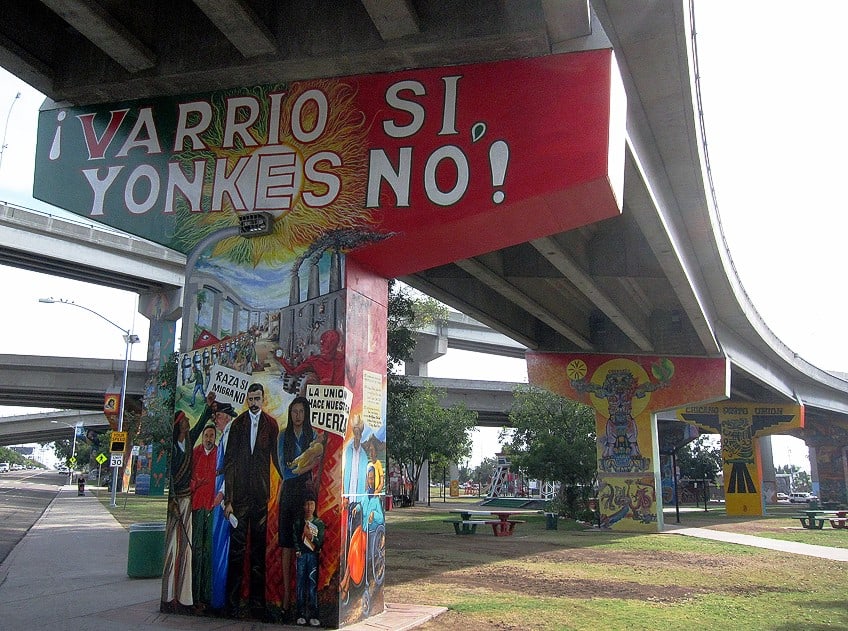
Young artists who took part in the Chicano art movement formed collectives, as the art movement aimed for collective identity and community, such as Asco, a collective located in Los Angeles, California in the 1970s. Asco was a group of high school graduates who were pursuing and contributing to the Chicano art movement.
Another group, known as the National Farm Workers Association, or the NFWA, aimed to unionize Mexican-American workers and servicemen, to improve working conditions and wages. The group was founded by César Chávez, Dolores Huerta, and Gil Padilla, who organized protests, marches, strikes, and boycotts to raise awareness on a national scale.
They made use of symbols, such as the black eagle, and produced posters and union art, which all were incorporated into Chicano art and vice-versa.
Chicano Art as a Form of Activism
Although the Chicano movement dwindled as time went on, the art movement continued to thrive as an outlet for activism, constantly bringing attention to and challenging the dominant social constructions of race and ethnic discrimination, as well as issues of citizenship, gender roles, and the exploitation of labor. This activism through art was expressed by representing alternative narratives and subject matter.
Featuring the Mexican-American as the focus of pieces was in itself new to the more White-Dominated subject matter of the contemporary art forms, but Chicano art also highlighted illustrations of historical injustices and human rights violations that the Mexican-American people faced, becoming a tool of both artistic expression as well as education for audiences who may not be informed on the matter.
Chicano artists often spread their messages through silk-screen posters, which were mass-produced in large quantities, for public consumption, which helped to spread the message of the movement.
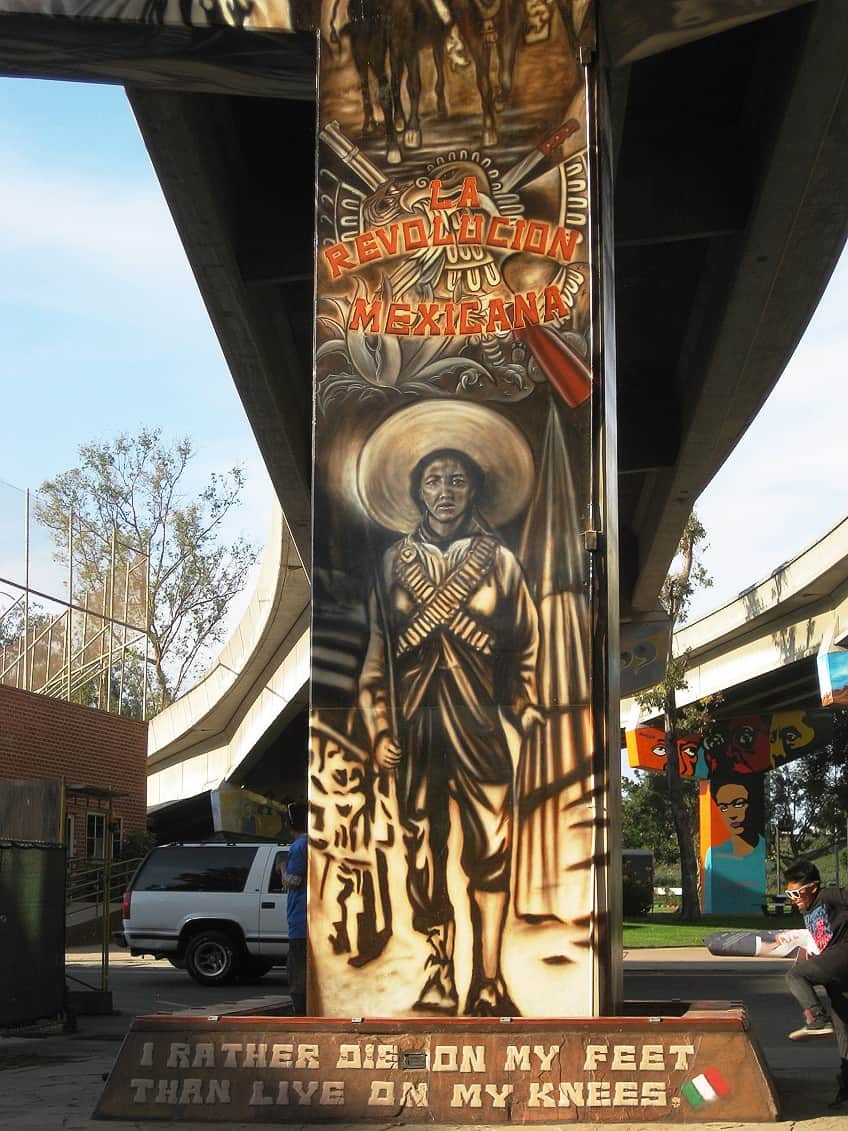
Bringing light to these social issues is the first step to bringing about change, and also made Mexican-Americans feel more empowered to fight for their freedom and construct their own identity and solutions. Another example of how Chicano art was used for activism was in the case of the Chicano People’s Park in San Diego, California. The Mexican-American neighborhood of Logan Heights had petitioned for a community park for years but was completely ignored.
Instead, the city began to construct an intersection for the interstate five freeway and an on-ramp for the Coronado Bridge in the 1960s. They tore down large areas of the suburb, displacing 5000 Mexican-American residents. Along with planned peaceful protests, Chicano muralist Victor Ochoa painted murals on the concrete walls in the area, which featured historic Chicano figures such as Cesar Chavez and La Virgin de Guadalupe.
Eventually, the city agreed to the development of a park, with Activist and artist, Salvador Torres establishing the Chicano Park Monumental Mural Program, which encouraged Chicano artists to fill the park with murals.
These murals highlighted the park’s heritage and community with Mexican-American art, including Chicano figures such as the indigenous Aztec imagery, like Coatlicue, the Aztec Earth Goddess.
Chicano Art as an Expression of Community
Chicano art is a form of cultural art, expressing community values and unity amongst Mexican-American people. With the example of the Chicano People’s Park, all the art displayed throughout the park focus on community-oriented ideas, with murals created by Chicano muralists and painters. These murals usually encourage a sense of community participation, often involving other Mexican-Americans in the development and creation of the murals, whether that be formulating ideas for the subject matter or actually painting the murals themselves.
The Chicano art movement is considered widely to be a community-based movement, which has developed into two significant mediums; muralism, which refers to the large paintings or murals painted on walls in public spaces and cultural art centers.
These centers developed during the Chicano movement to act as a space for alternative structures that supported Mexican-American artists, as well as artistic creation in general. These cultural art centers also aided in the unification of communities and helped spread information on the Chicano movement and its messages.

These centers not only encouraged and created a space for community gatherings but also acted as a cultural space; where Chicano artists, muralists, and enthusiasts could engage in discussions and dialogues on the Chicano movement as it developed. It also acted as a space for Mexican-Americans to discuss issues and topics that were coming up in Mexican-American communities in general.
The Self-Help Graphics and Art Inc. center is an example of one of these cultural centers, which served as a venue for silkscreen printmaking as well as a space for housing art exhibitions.
Chicano Art as an Expression of Cultural Identity
As previously stated, Chicano art serves as an expression of identity and cultural affirmation for the Mexican-American people. One way this is expressed in the art is through the Chicano artist’s and muralist’s use of religious imagery. This includes both the indigenous religions of the Aztec, Inca, and Mayan people, as well as Catholicism, which has become a significant element of Mexican culture.
One popular religious figure that often features in Chicano paintings and murals is La Virgen de Guadalupe, or the Virgin of Guadalupe, who is a very prominent figure in Mexican culture.
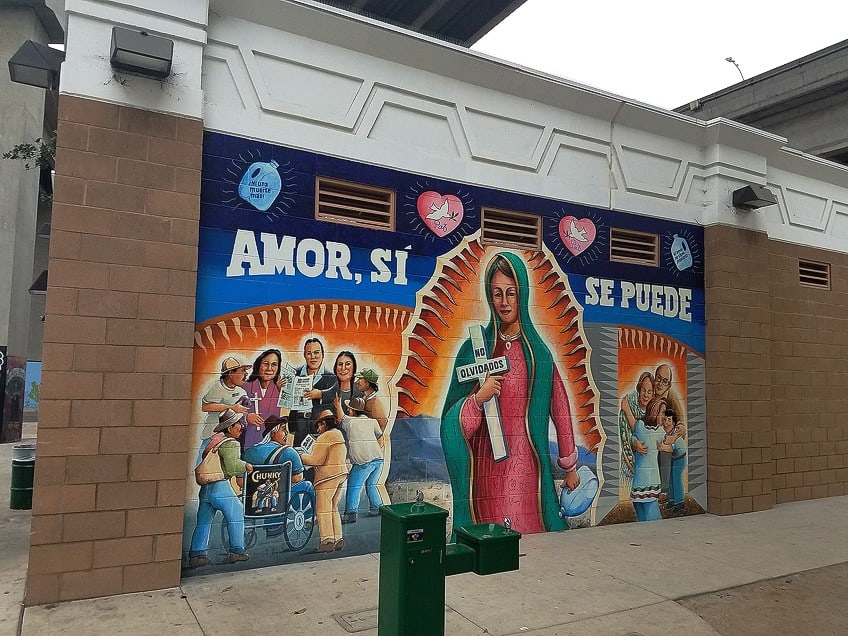
This was often used to represent hope during difficult times, or even empowerment, particularly female empowerment. Both Mexican, as well as Indigenous Latin-American cultures often celebrate their religious heritage through the use of shrines.
The Chicano art movement has taken the idea of shrines, with its religious imagery, and incorporated it into its murals, often making use of the same type of compositions.
An important cultural and religious holiday within the Mexican culture is what is known as the Day of the Dead, which focuses on family by remembering and honoring their ancestors and loved ones who have passed away. This holiday is celebrated alongside the Catholic All Saints’ Day and All Souls’ Day, which takes place from November 1st to November 2nd. As this day is a highly honored day within the Mexican culture, it is often featured as the subject matter of Chicano art.
Chicano Art as an Expression of Life in the Barrio
The word barrio is a Spanish term that means “quarter” or “neighborhood”, referring to the city areas that are inhabited by Spanish-speaking citizens. In the modern form of the Spanish language, Barrio usually refers to areas that are delimited by functional, social, or architectural features.
In the United States specifically, barrios refer to inner-city areas that are dominantly populated by Mexican-American, or Latin American, people, often referring to first-generation immigrant families that have not assimilated into the mainstream White American culture. Examples of these inner-city areas include East Los Angeles, Segundo Barrio in Houston, and Spanish Harlem, New York City.
Chicano art often features representations of life in the Barrios.

These areas often have histories of oppression, marginalization, inequity, poverty, gang violence, and dislocation. This art is often expressed by the community, often with the medium of graffiti. Graffiti is generally considered to be a form of vandalism, with Barrios especially, as graffiti is often used by gangs as marks of territory, marking unofficial borders.
Chicano art embraced this, however, as it is usually associated with the rebellion against authority. Chicano artists used graffiti to express their political opinions, as well as their native history and religious iconography.
Thus, graffiti within the barrios became culturally affirming, promoting Latin heritage, facilitating dialogue, and bringing light to injustices that have affected the Mexican-American communities. Graffiti has recently been reclaimed as a form of public art. Art museums and galleries have embraced graffiti, with many artists featuring forms of graffiti in their work. The medium has become recognized by both art institutions and art critics.
Notable Artists and Artworks of the Chicano Art Movement
The Chicano Art movement was built from the ground up, founded by a generation of artists within the Chicano community, the 1960s and 1970s saw some of these artists rise, gaining praise and recognition for their culturally affirming works. Artists like Carlos Almaraz had their work gain so much recognition that they were accepted into the mainstream art scene, joining American art galleries.
Today, many of these artists and their works can be found at the Smithsonian American Art Museum.
Magú (1940 – 2011)
| Artist | Gilbert “Magú” Luján |
| Birth/Death Year | 1940 – 2011 |
| Nationality | American |
| Notable Works | Returning to Aztlan (1983) Cruising Turtle Island (1986) El Fireboy y El Mingo (1988) Having a Car Baby (2004) Gender Consensus (2005) |
Gilbert Luján, also known as “Magú”, was a dedicated Chicano artist and intellectual who helped to establish the Chicano art movement in the 1960s and 1970s. He was born to Indigenous Mexican parents but grew up in Los Angeles, where he studied art and ceramics at East Los Angeles College, as well as California State University.
Magú is considered a visionary for the Chicano art movement, painting murals and creating public art installations all around Los Angeles and California, before joining Los Four.
His work had a major influence on the movement, defining the general art style and aesthetics. In 1969, as the Chicano art movement was rising, Magú noted that there was a Chicano art form that had existed for years, without formalization and recognition. He continued to explain that the awareness of one’s “cultural linkage” to Mexico and India illustrates that “the Chicano culture is a real and identifiable body.”
Magú’s art is praised for its rich texture of cultural history, often seen in his use of color and imagery.
These are often incorporated traditional brut and folk art, as well as indigenous Latin American Mythology. His most recognizable trademark is the figure of an anthropomorphized dog figure, similar to those seen in Ancient Egyptian mythology, which is meant to represent indigenous Mexican mythology.
El Fireboy y el Mingo (1988)
| Title | El Fireboy y el Mingo |
| Artist | Gilbert “Magú” Luján |
| Medium | Color lithograph on paper |
| Dimensions (cm) | 76.2 x 111.8 |
| Date Created | 1988 |
| Current Location | Smithsonian American Art Museum |
This Chicano art drawing perfectly embodies Magú’s rich use of color about his cultural history. The inclusion of the anthropomorphized dog character also highlights indigenous Mexican mythology. The title of this Chicano art drawing translates to “the fireboy and the mingo”.
The word “mingo” in the Spanish language is used to describe men that are well-dressed and composed.
This gives the piece a sense of irony, in that there is decency and composure in the more indigenous-representative character. This piece is currently housed at the Smithsonian Art Museum but is currently not on view.
Carlos Almaraz (1941 – 1989)
| Artist | Carlos Almaraz |
| Birth/Death Year | 1941 – 1989 |
| Nationality | American |
| Notable Works | El Corazon del Pueblo (1976) Europe and the Jaguar (1982) I Dreamed I Could Fly (1986) Homage to Still Life (1986) Night Magic/Blue Jester (1988) The Struggle of Mankind (1989) |
Carlos Almaraz was an artist and leading figure of the Chicano art movement in the 1970s. Born in Mexico City before immigrating to East Los Angeles with his family, Almaraz earned his Master’s in Fine Arts from Otis College of Art and Design. He was involved in the political activist part of the movement as well, producing banners, posters, paintings, and murals for the rallies in support of Cesar Chavez’s United Farm Workers labor union. He also was involved in Luis Valdez’s Teatro Campesino and Mechanicano, which was a cooperative Chicano art gallery in East Los Angeles.
Almaraz, along with a few other Chicano artists, founded the local Chicano art collective, Los Four, which brought the movement to the attention of the Los Angeles art scene.
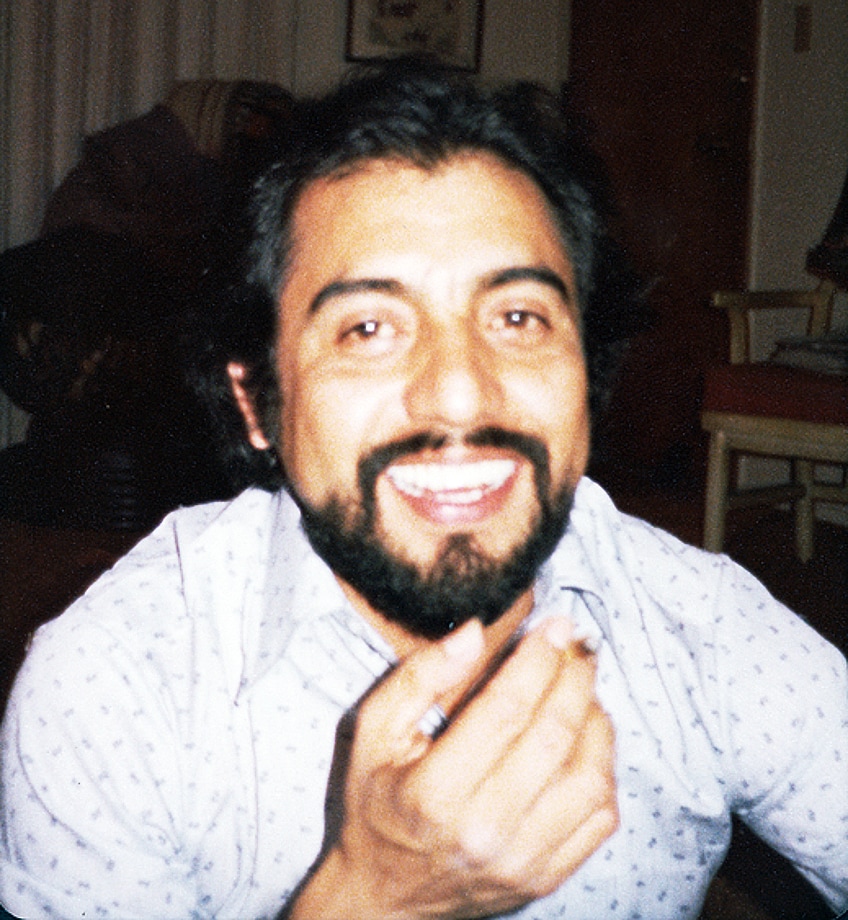
Almaraz, along with Chicano muralists Frank Romero, Gilbert “Magú” Luján, and Robert de la Rocha, painted public murals throughout the city, which featured representations of the civil rights issues faced by Mexican-Americans, with the expressive use of bold colors, with purple, pink and orange hues commonly used.
Europe and the Jaguar (1982)
| Title | Europe and the Jaguar |
| Artist | Carlos Almaraz |
| Medium | Oil on canvas |
| Dimensions (cm) | 182.9 x 182.9 |
| Date Created | 1982 |
| Current Location | Smithsonian American Art Museum |
This Chicano artwork is an oil painting that shows Almaraz’s, as well as other Chicano painters’, expressive use of bold colors, as seen with the bright orange representation of the jaguar in comparison with the blue European figure. This work is currently housed at the Smithsonian American Art Museum but is currently not available for viewing.
As Chicano painters often used their paintings to express their culture and politics, this piece clearly shows the juxtaposition between the European colonizers, or even the White Americans, and the native Mexican and Central American people.
Chaz Bojórquez (1949 – Present)
| Artist | Charles Bojórquez |
| Birth/Death Year | 1949-Present |
| Nationality | American |
| Notable Works | Somos La Luz (1992) New World Order (1994) Placa/Rollcall (1980) |
Charles Bojórquez, also known as “Chaz” is a Chicano painter and graffiti artist, and is one of Los Angeles’ first well-known graffiti artists. He is widely credited as one of the prominent artists that brought the Chicano art movement to the attention of the mainstream.
Beginning his career in the 1970s, he would tag the name ‘Chaz’ around Highland Park in Los Angeles, which translates to “the one who messes things up and likes to fight.”
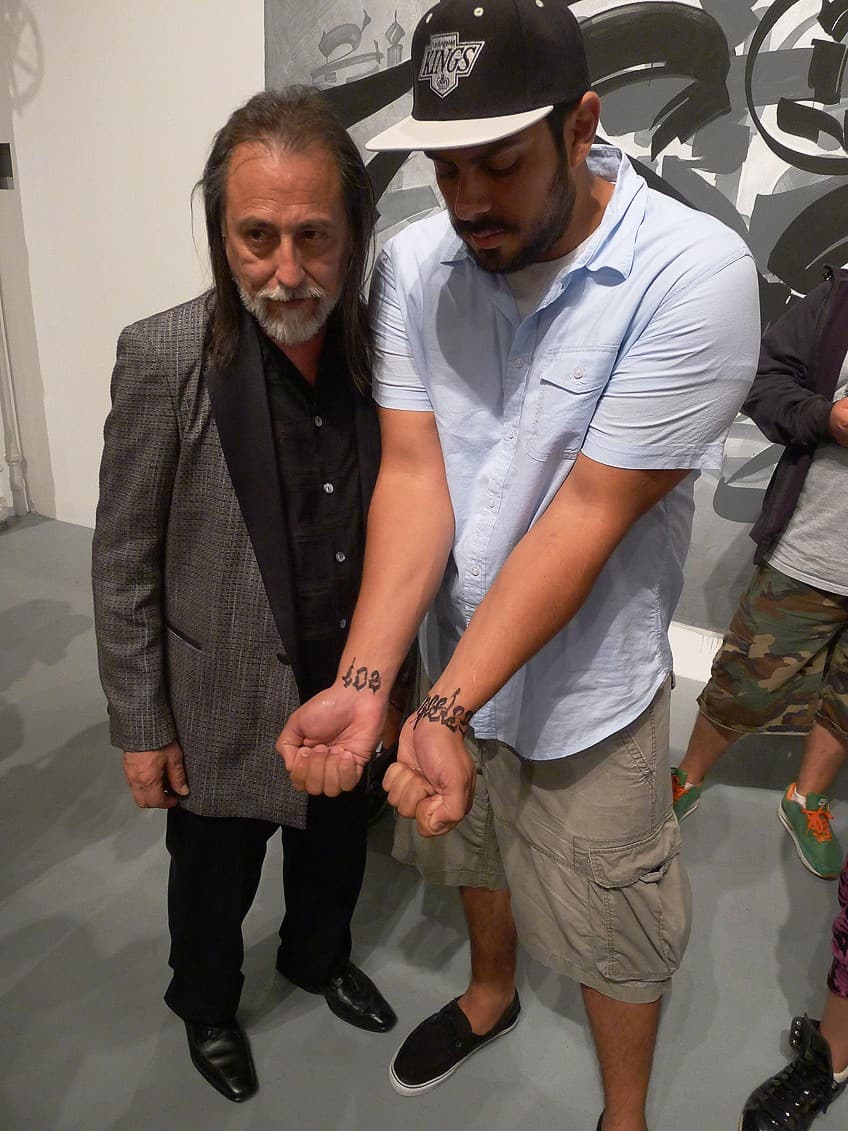
He went on to study art at the University of Guadalajara as well as California State and Chouinard Art Institute. His work was highly influenced by the Chicano artists that came before him, such as Gilbert “Magu” Luján.
Chaz is most known for his work in Cholo-style calligraphy. This style is considered to be one of the oldest forms of the medium, having been invented in the 1940s by Mexican-American gang members as marks of territory. These often included roll calls or lists of gang members.
Chaz studied Asian calligraphy at the Pacific Asian Art Museum and visited more than 30 countries to develop his signature style, looking at how other cultures incorporated culture and identity into their calligraphy, graphics, and letters. Bojórquez, along with other Chicano artists, all developed their style of graffiti art, and this eventually went on to be known as West Coast Cholo, which was heavily influenced by Mexican muralism and pachuco placas, which refers to tags indicating territorial boundaries, a homage to how the Mexican-American gang members would mark their territories.
Placa/Rollcall (1980)
| Title | Placa/Rollcall |
| Artist | Charles “Chaz” Bojórquez |
| Medium | Acrylic on canvas |
| Dimensions (cm) | 173.4 x 211 |
| Date Created | 1980 |
| Current Location | Smithsonian American Art Museum |
This artwork was inspired by the graffiti made by gang members throughout the barrios, with Bojórquez listing his mentors and friends on the roll call, in the same way, that these graffiti artists would list the members of their gangs. The term placa refers to the denotation of territory and neighborhood loyalty.
This connection between graffiti and Chicano art represents how the movement expresses the culture, incorporating traditional calligraphic forms in the piece.
Richard Duardo (1952 – 2014)
| Artist | Richard Duardo |
| Birth/Death Year | 1952 – 2014 |
| Nationality | American |
| Notable Works | Aztlan (1982) |
Richard Duardo was a pivotal figure in the Chicano art scene, particularly when it came to printmaking. He was born in Boyle Heights, Los Angeles in 1952, and graduated with a Bachelor of Arts in graphic design from Pasadena Community College as well as a Master’s degree in Fine Art from UCLA. Duardo worked with the well-known self-help graphics art center that specialized in printmaking, before moving on to co-found the Centro de Arte Público in the late 1970s, which was a well-known highly political arts collective in Highland Park, Los Angeles.
Today, Duardo is best-known for his screen printing, often known as the “West Coast Warhol” (a reference to the artist, Andy Warhol).
He was one of the founders of Modern Multiples, which was a print shop in California that was quite prominent and influential within the Chicano movement. Modern Multiples continues to this day, using their art for community building and affirmation.
Duardo worked with more than 400 artists, including Banksy, David Hockney, and Shepard Fairey, and was commissioned for several highly-publicized projects, including promotional art for the Biopic film, Frida (2002), which also focused on Mexican-American heritage and culture. Duardo’s signature style involved transforming great art into stunning prints.
He produced colorful, large-scale prints of well-known and famous musicians such as Jimi Hendrix, Che Guevara, Lauren Becall, Bob Dylan, Duke Ellington, Miles Davis, and Madonna.
He also produced prints of other famous artists, such as Frida Kahlo, David Hockney, Chaz Bojórquez, Mick Haggerty, Banksy, and Andy Warhol himself. He eventually went on to found Future Perfect Publishing, which was a silkscreen printing studio where he was able to put his expert printmaking skills to use, gaining him international recognition, as the best serigraph artist in Los Angeles, eventually going on to be named Artist of the Year in 1988.
Aztlan (1982)
| Title | Aztlan |
| Artist | Richard Duardo |
| Medium | Screenprint on paper |
| Dimensions (cm) | 64.1 x 97.2 |
| Date Created | 1982 |
| Current Location | Smithsonian American Art Museum |
This allegorical artwork made in 1982 not only expresses Duardo’s signature style but also refers to the indigenous Chicano culture. This Chicano art drawing, a screen-print on paper, is another example of the use of calligraphy by Chicano painters.
The piece features the word “Aztlan” across it, which refers to the ancestral home of the native Aztec people.
Historians and archaeologists have speculated about the possible location of this lost land, placing it around northwestern Mexico, though some believe it to be completely mythological, a part of the Aztec culture’s folklore.
Yreina Cervántez (1952 – Present)
| Artist | Yreina Cervántez |
| Birth/Death Year | 1952-Present |
| Nationality | American |
| Notable Works | Homenaje a Frida Kahlo (1978) |
Yreina Cervántez is a Chicano artist, muralist, and feminist that was born in Garden City, Kansas in 1952. Her art is well-known to be an expression of the cultural as well as personal experiences of the Chicano people.
She is considered to be a pioneer when it comes to her role in the push for women to be included in the mainstream art movements of the time, particularly the Chicano Art movement.
Cervántez attended the University of California Santa Cruz, becoming immersed in the Civil Rights Movement and joining the university’s Third World Coalition group. Her experience in these environments heavily influenced her art, which became highly political, representing the struggles faced by the Mexican-American community, such as the issues Mexican and Central American immigrants were dealing with when it came to being documented and fully accepted as US citizens.
Her work was very transformative and included representations of Chicana feminism, which refers to the socio-political movement that looked at the intersectionality of history, culture, education, and spirituality that made up the Chicano women, breaking down the barriers of gender, ethnicity, race, class, and sexuality.
Cervántez also produced self-portraits that expressed the idea that the personal and the political were, in fact, linked, providing Mexican and Latin American women representation in art.
She eventually became the artist in residence at El Centro de La Raza in California, where she would provide these women with the resources they needed, through the La Nueva Chicana: Homegirl Productions program. She also became the artist in residence of the store Self-Help Graphics, after gaining much praise and recognition for her art piece, Homenaje a Frida Kahlo (1978).
Homenaje a Frida Kahlo (1978)
| Title | Homenaje a Frida Kahlo |
| Artist | Yreina Cervántez |
| Medium | Watercolor paint on canvas |
| Dimensions (cm) | 50.8 x 35.56 |
| Date Created | 1978 |
| Current Location | Los Angeles, California |
This watercolor painting depicts the Mexican artist, Frida Kahlo, as a symbolic representation of Chicano culture. Kahlo is a prominent figure in the field of art and art history, and given Cervántez’s push for feminism in her work, Kahlo is a great representation.
The piece depicts the artist as a divine being, with a halo around her head similar to those seen in Renaissance paintings of the Virgin Mary, which echoes the Catholic culture present in Mexico.
The use of color and symbolism also captures the native symbology and culture that many famous Chicano artists aimed to express. Along with several other artists, Cervántez created a multi-media installation piece entitled, !Alerta! (1987), which expressed the issues of immigration. She also went on to join a Chicano delegation that traveled to Managua, Nicaragua to construct a bridge, which involved creating a mural entitled La Ofrenda (1989).
La Ofrenda (1989)
| Title | La Ofrenda |
| Artist | Yreina Cervántez |
| Medium | Acrylic paint on cement ground |
| Dimensions (cm) | 91.44 x 50.8 |
| Date Created | 1989 |
| Current Location | Los Angeles, California |
This mural is one of nine that were painted across California by the SPARC’s Neighborhood Pride Mural Program. The piece is located under a bridge on Toluca and Second Street, in Los Angeles, and features imagery related to the United Farm Workers of America, with the term ‘Ofrenda’ translates to offering in Spanish.
The mural was unfortunately lost under layers of vandalism and graffiti over the decades by locals but was restored close to its original state in 2016 by the CityWide Mural Program.
The Chicano art movement is one of the most important art movements in recent American history, founded by a generation of artists aiming to develop their own identity in the art field that both represented and affirmed their racial and cultural identity. The movement continues to this day, growing, evolving, and adapting along with the community of Mexican-Americans and the struggles they continue to face.
Frequently Asked Questions
What Does the Term Chicano Mean?
The term Chicano or Chicana refers to the chosen identity of Mexican-Americans in the United States. The term was popularized by the Chicano Movement in the 1960s, used by Mexican-born or originated immigrants as a political and proud expression of culture, ethnicity, and community.
Why Is Chicano Art Important?
The Chicano movement aimed to promote cultural affirmation and community for Mexican-American people, with the art movement doing the same; using the mediums of art to express culture, cultural values, heritage, and aesthetics. Often, Chicano art would use social issues faced by the Chicano people as the subject matter, depicting representations of class struggle, immigration issues, and displacement.
When Did the Chicano Art Movement Start?
The Chicano art movement was historically defined as art created by Americans of Mexican descent, often depicting expressions of their culture, community, and shared struggles. The Chicano art movement began to emerge in the late 1960s and early 1970s as the art of struggle.
What Was the Main Purpose of the Chicano Art Movement?
The Chicano art movement aimed to remind the Mexican-American people of their cultural identity and heritage, as well as the contributions previous generations have made to the advancement of the Latin-American people in the United States. The movement was also a rejection of the mainstream white American culture, which was also present in the art scene.
What Are Chicano Murals?
Murals were a prominent part of the Chicano art movement, established in the late 1960s throughout the Southwest in Mexican-American barrios, particularly in Los Angeles. These Chicano muralists depicted Mexican-American culture by painting on the walls of buildings, schools, and churches, as well as housing projects throughout the city. This allowed the art to be viewed by the public, and by placing it within the barrios, it helped to create a sense of cultural pride within the community.
What Constitutes Chicano Art?
Chicano art is generally defined as artwork that is created by American people of Mexican descent. The art is heavily influenced by the Chicano movement in the United States and often features themes that relate to the movement, cultural affirmation, pride, heritage, and community. Chicano muralists and artists usually incorporated cultural motifs, imagery, and iconography from different time periods throughout their historical heritage, including imagery inspired by the Indigenous cultures of the Aztec, Inca, and Mayan people, as well as post-colonial religious imagery, usually Catholicism.
Isabella studied at the University of Cape Town in South Africa and graduated with a Bachelor of Arts majoring in English Literature & Language and Psychology. Throughout her undergraduate years, she took Art History as an additional subject and absolutely loved it. Building on from her art history knowledge that began in high school, art has always been a particular area of fascination for her. From learning about artworks previously unknown to her, or sharpening her existing understanding of specific works, the ability to continue learning within this interesting sphere excites her greatly.
Her focal points of interest in art history encompass profiling specific artists and art movements, as it is these areas where she is able to really dig deep into the rich narrative of the art world. Additionally, she particularly enjoys exploring the different artistic styles of the 20th century, as well as the important impact that female artists have had on the development of art history.
Learn more about Isabella Meyer and the Art in Context Team.
Cite this Article
Isabella, Meyer, “Chicano Art – Discover the Mexican American Art of Chicano Painters.” Art in Context. July 5, 2022. URL: https://artincontext.org/chicano-art/
Meyer, I. (2022, 5 July). Chicano Art – Discover the Mexican American Art of Chicano Painters. Art in Context. https://artincontext.org/chicano-art/
Meyer, Isabella. “Chicano Art – Discover the Mexican American Art of Chicano Painters.” Art in Context, July 5, 2022. https://artincontext.org/chicano-art/.




